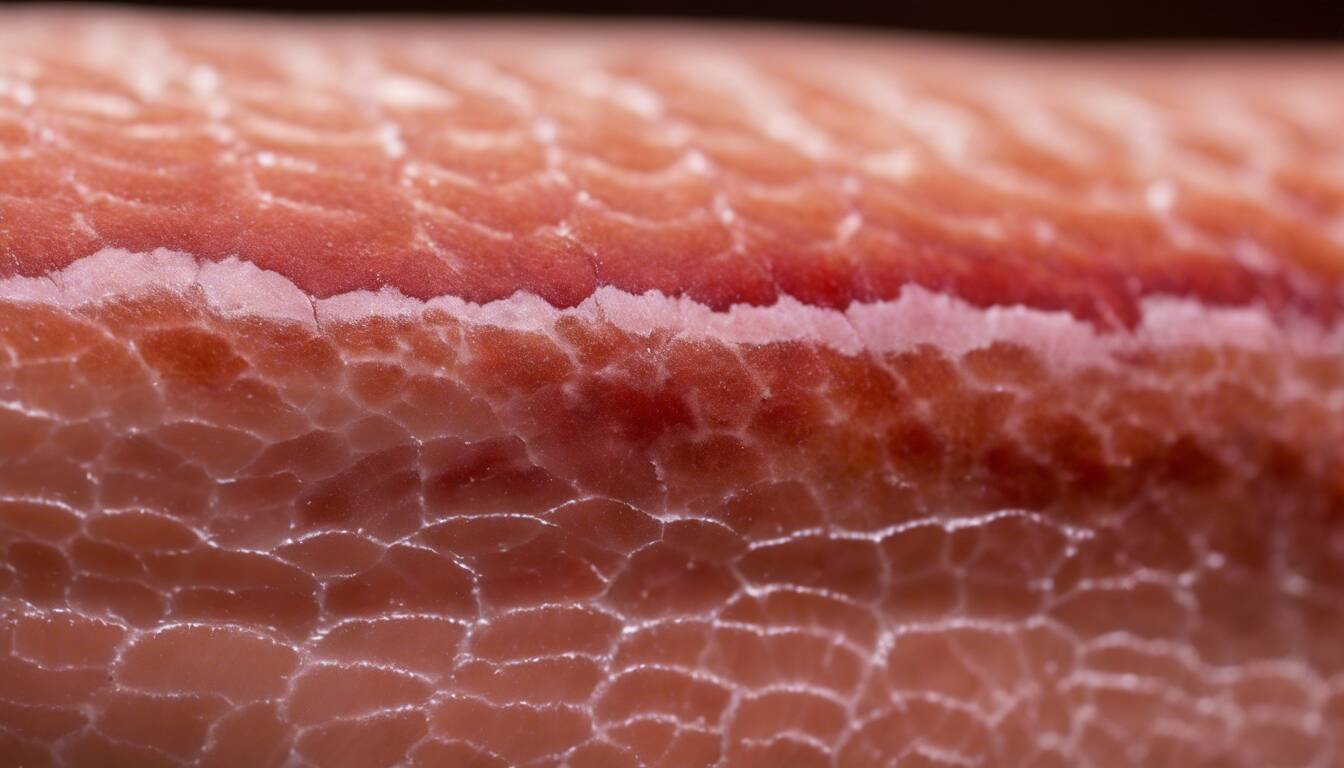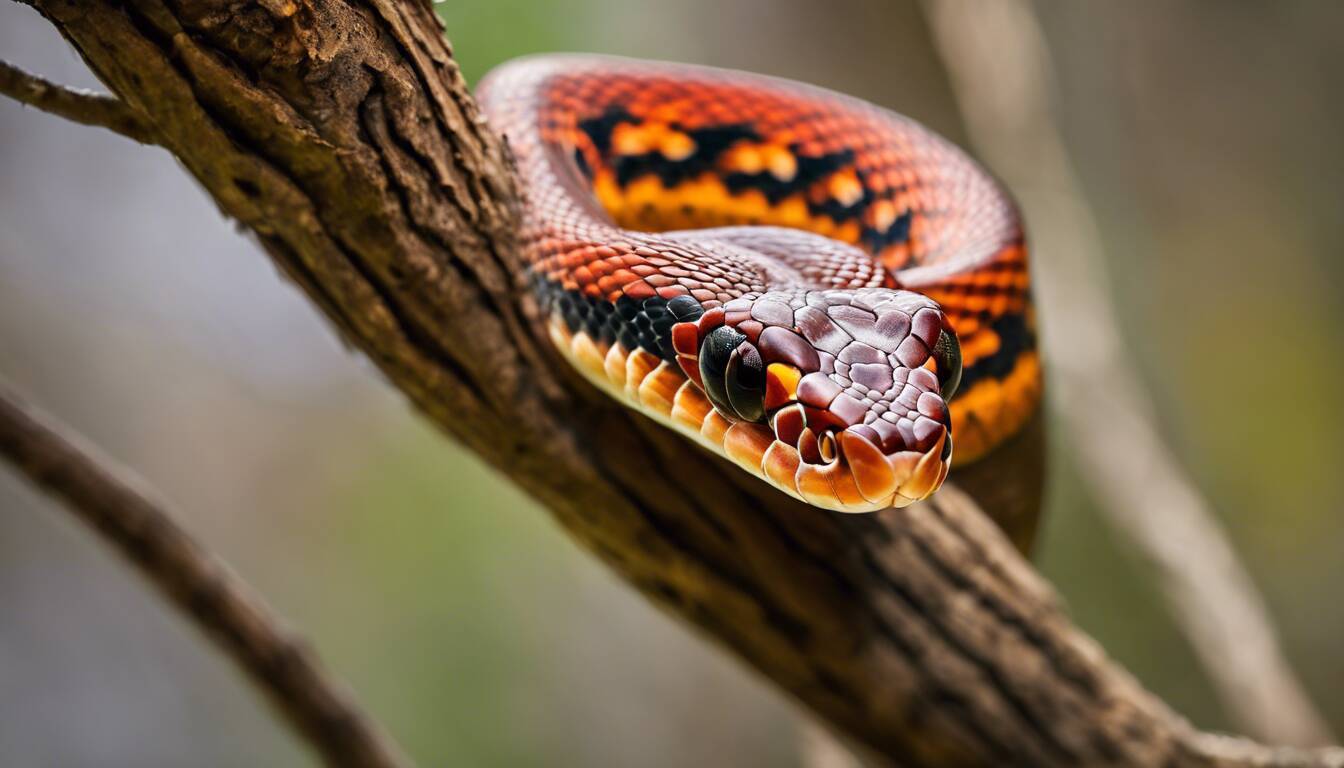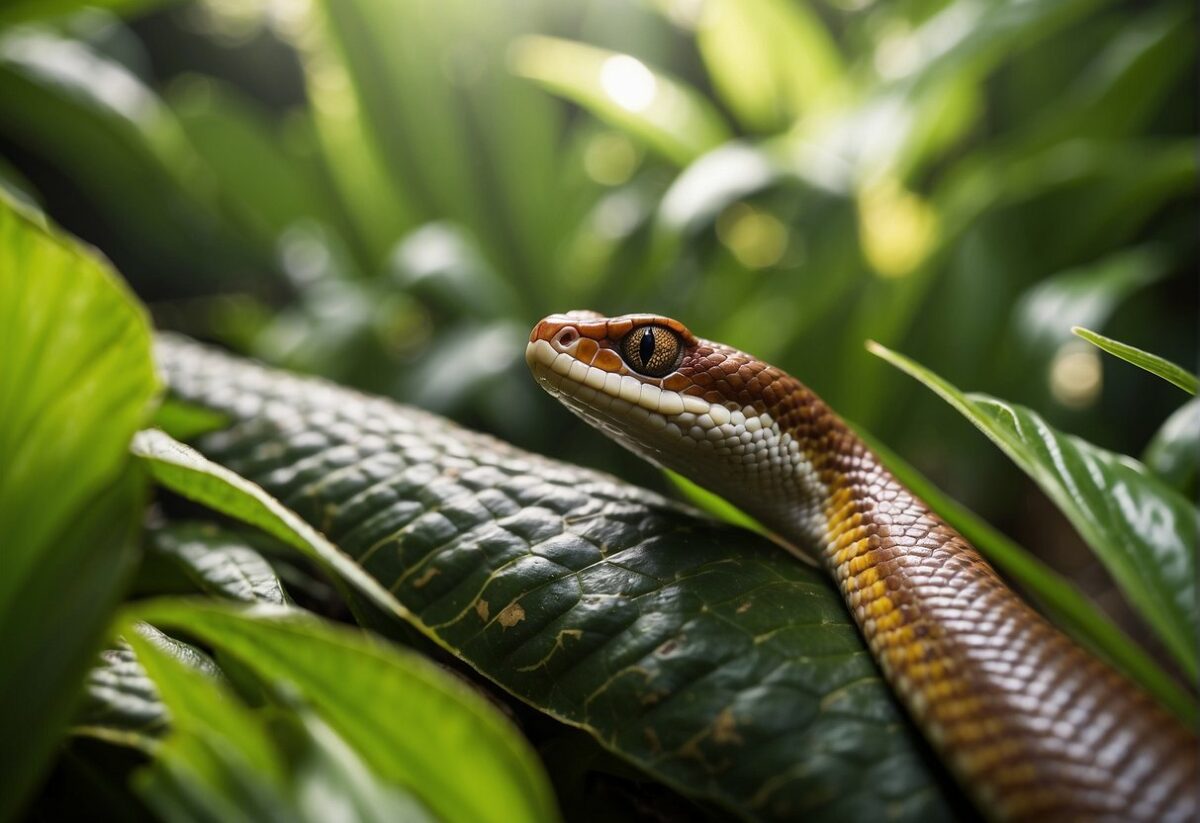A corn snake bite, resembling two tiny puncture wounds akin to pinpricks, is usually minor and draws minimal blood. The location of the bite depends on where the snake came into contact with you, often being your hands or extremities. However, even though it may look negligible at first glance due to its shallow depth and small size, neglecting proper cleaning and care could lead to complications. Now imagine you’ve been bitten—what steps should you take?
It is important to immediately clean the bite area with mild soap and water, apply an antiseptic ointment, and cover it with a bandage. Keeping the area clean and watching for any signs of infection such as redness or swelling is crucial. If you experience any concerning symptoms, seek medical attention promptly.
What Do Corn Snake Bite Marks Look Like?
When it comes to identifying corn snake bite marks, it’s important to remember that they are not always easy to distinguish at first glance. Typically, these bite marks appear as two small puncture wounds, usually about 1/8 inch apart. The skin around the puncture wounds may also appear red and swollen, with some bruising around the area.
These bite marks are a result of the snake’s upper and lower rows of teeth, creating shallow incisions that draw minimal blood. The pain is typically mild, often compared to a pinprick or a mild bee sting. In some cases, there may be signs of minor bleeding or oozing of clear fluid around the bite marks.
Furthermore, it’s essential to note that everyone’s body reacts differently to snake bites. While one person may experience mild discomfort, another person may feel more pronounced pain. It is also quite normal for the area around the bite marks to still be raised and swollen up even a week after the bite. However, these symptoms should gradually subside with time and proper care.
In addition to the physical appearance of the bite marks, some individuals might experience mild itching and swelling in the area after a snake bite. If at any point you suspect an infection, it’s crucial to inspect the bite for broken teeth as they can cause issues, and promptly disinfect the site with iodine or a similar antiseptic agent.
Remember: Disinfecting the site after a snake bite is recommended due to bacteria present in snake mouths.
It’s also important to keep in mind that allergic reactions to snake saliva are possible. Therefore, anyone who has been bitten should observe symptoms closely and consider taking antihistamines such as Benadryl to address any potential allergic reactions.
In all cases, monitoring and caring for these bite marks properly are crucial steps in aiding recovery and preventing complications from arising.
Understanding corn snake bite marks provides valuable insight into their impact on humans. Now, let’s delve into exploring the size and location of these bites in greater detail.
Size and Location of the Bite
The size of a corn snake bite mark can vary depending on factors such as the snake’s size and the force of the bite. Typically, you would notice 1-2 small puncture wounds, which are usually about 1/8 to 1/4 inch apart.
When handling a corn snake, your hands, fingers, or arms are typically the main areas of contact with the snake. It’s natural for a corn snake to strike at these points when it feels threatened. The reason for this is simply that these parts are considerably closer to the snake than any other part of your body most of the time.
Corn snakes do not attack humans in an aggressive manner, but they will strike if they feel threatened by your actions or overexerted handling. The bites themselves are generally rather small due to their non-venomous nature.
Corn snakes have teeth but not fangs. Therefore, the depth and impact of their bites are significantly less severe compared to venomous snake bites. Given their small size and limited ability to penetrate deep into the skin, corn snake bites are relatively harmless and typically cause minor discomfort.
Understanding the characteristics of a corn snake bite, from its size to its typical location, is essential in comprehending how minimal their effects can be.
Color Changes in the Skin Post-Bite
The area around a corn snake bite can undergo various color changes as a response to the trauma. Immediately following the bite, redness around the puncture wounds may be noticeable. This redness occurs due to the skin’s response to minor irritation and increased blood flow to the affected region.
As time passes—typically within a few hours—the redness may intensify, and the affected area might become warm to the touch. These are signs that the body is sending blood, enriched with healing properties, to the wounded region in an attempt to repair any damage caused by the bite. It’s important to note that individual skin reactions may vary based on factors such as sensitivities and immune responses. For instance, people with sensitive skin might exhibit more visible color changes compared to those with less sensitive skin.
Frequent observation of any color changes and understanding what is normal for your body is crucial in identifying any unusual or alarming deviations from expected healing patterns.
In some cases, bruising or purple discoloration around the bite site might be observed within a day or two. The appearance of bruising is often attributed to bleeding beneath the skin caused by damage to blood vessels during the bite. However, this discoloration should subside within a few days as part of the natural healing process.
It’s important to highlight that while these color changes are largely normal aspects of the body’s response to injury, monitoring for unusual or prolonged discoloration is crucial. While minor bruising is routine and should dissipate, excessively dark or persistent bruising may necessitate medical attention as it could indicate complications requiring intervention.
For further insight, imagine your skin after a bump – initially, it turns red due to increased blood flow, much like in response to a snakebite. Similarly, the swelling after a bite can be likened to how your skin reacts when stung by an insect or injured.
Understanding these post-bite color changes can provide reassurance and facilitate informed decision-making when managing healing processes following a benign snake encounter. Ultimately, closely monitoring and noting any remarkable skin color variations allows for the timely identification of concerning developments that warrant prompt medical evaluation.
Anatomy of a Corn Snake Bite
Let’s explore the fascinating physiology behind a corn snake’s bite. Their teeth are specially designed for grasping and holding onto prey rather than delivering venom. These recurved teeth help the snake maintain a firm grip on its prey as it constricts. Unlike other venomous snakes, such as vipers or cobras, corn snakes lack fangs for injecting venom. This means that their bite itself is generally not dangerous to humans and causes minimal discomfort compared to other animals.
The absence of venom in corn snakes means that their bites do not pose any significant danger to humans. The bite marks consist of 1-2 small puncture wounds with a depth ranging from 1-2 millimeters and a width of 3-5 millimeters. Despite causing some mild discomfort, the pain associated with a corn snake bite is generally comparable to a minor pinch and does not lead to severe symptoms.
In addition to their non-venomous nature, the small size of a corn snake’s teeth also contributes to the relatively minor impact of their bites. These small, slender teeth are well-suited for gripping and holding prey, rather than inflicting harm on larger animals like humans.
To put things into perspective, getting bitten by a corn snake can be less painful than being bitten by a dog. Their bites are gentle, causing shallow punctures and generally drawing little to no blood. Furthermore, their docile nature makes them unlikely to bite humans unless they feel threatened or provoked, making them suitable pets for both beginners and experienced reptile enthusiasts.
Now, while corn snake bites are typically harmless, handling them with care is still important to prevent any unnecessary stress or injury to the snake. Remember that even though their bites are generally mild, there may be bacteria present in their mouths that could lead to mild infection if proper wound care is not observed.
With a deeper understanding of the non-venomous and relatively harmless nature of corn snake bites, it becomes clear how these fascinating creatures contribute to the world of reptiles as docile and captivating pets.
Through comprehending the benign nature of corn snake bites, we get closer into examining potential risks associated with interactions between humans and these intriguing reptiles.
Risks Associated with Corn Snake Bites
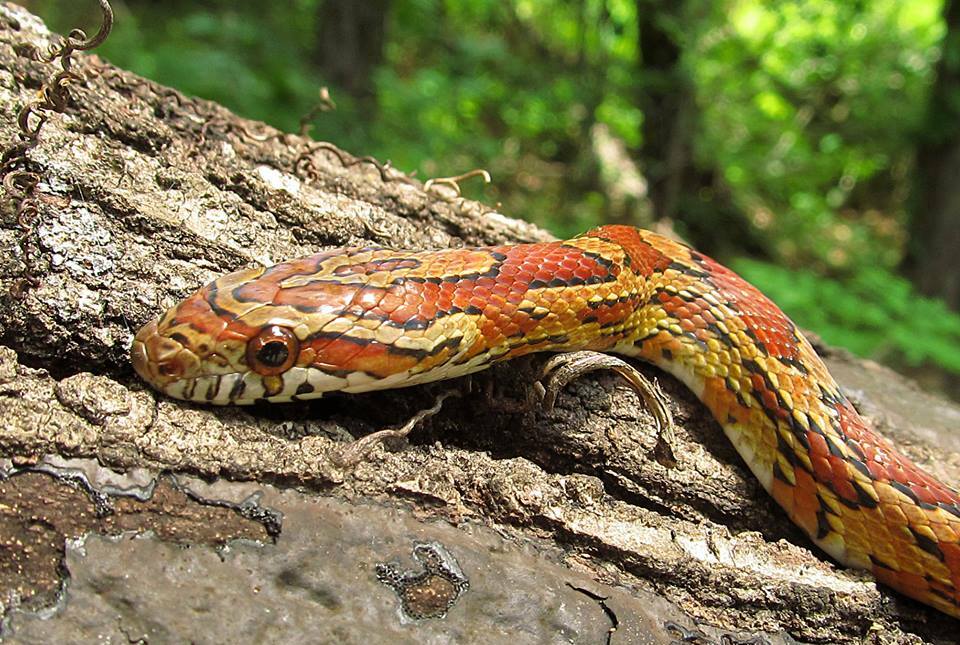
Corn snakes are generally very gentle and pose minimal risks to humans. However, the bacteria present in their mouths still pose a potential risk of infection from their bites. When a corn snake bites, it is possible for the bacteria in its mouth to enter the puncture wounds, potentially leading to an infection.
Bacteria like Salmonella have been identified in the mouths of some snakes, including corn snakes. This is significant because if not handled properly, these bacteria can cause mild infections in humans. Cleaning the bite wound thoroughly with disinfectants and seeking medical help promptly are vital steps to take after being bitten by a corn snake.
Preventive care is essential:
| After a Corn Snake Bite: |
|---|
| – Clean the wound thoroughly with an antiseptic solution. |
| – Watch for signs of infection such as redness, swelling, warmth around the bite area, or any pus drainage. These could indicate an infection and should prompt immediate medical attention. |
| – Consider seeking medical advice if you have concerns about the bite or are unsure about whether the wound has been adequately disinfected. |
It’s important not to underestimate the potential risk of infection from a seemingly harmless bite, as untreated infections can lead to more serious health complications.
For instance, a small child or someone with a weakened immune system may be at a higher risk of developing complications from an infected snake bite.
While the risks associated with a corn snake bite are generally minimal, taking proactive measures following such an incident is crucial in preventing potential complications. It’s all about creating a safe environment for both yourself and your pet corn snake.
By being proactive and well-prepared, you can ensure safety and peace of mind even after an unexpected encounter with a corn snake.
Safety Measures after a Corn Snake Bite
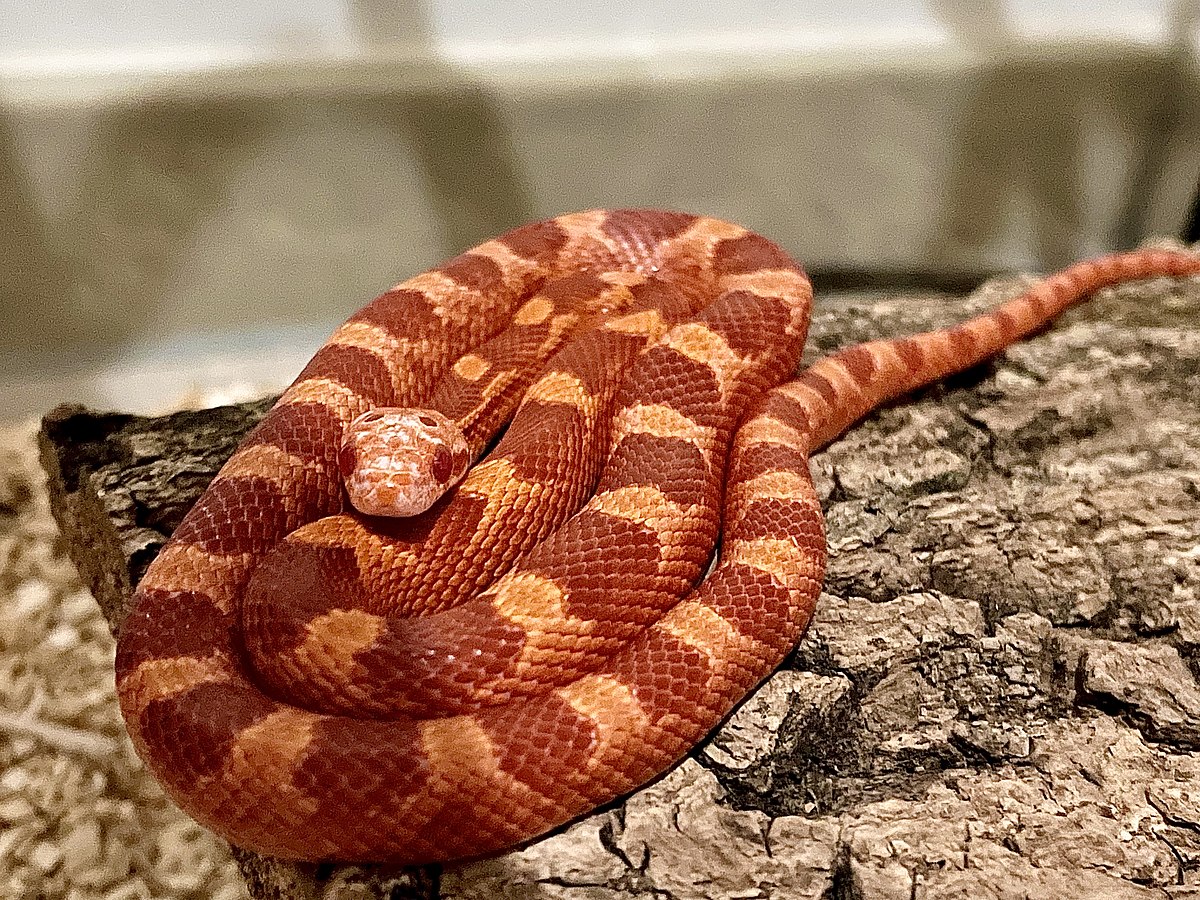
It’s natural to feel nervous if you’ve been bitten by a corn snake, but the most important thing is to stay calm and take care of the wound. The primary goal is to prevent infection and monitor the healing process closely. After a corn snake bite, it’s essential to:
Disinfect the Bite Area Thoroughly
First things first, wash the bite area with mild soap and water for about 5 minutes. This will help remove any bacteria or dirt that might have been introduced by the bite. After washing, further clean the area with an antiseptic for about 10 minutes. This thorough cleaning routine helps minimize the risk of potential infection, ensuring that any bacteria from the snake’s mouth is eradicated.
Monitoring for Signs of Infection
Keep a close eye on the bite area for any signs of infection in the days following the bite: itching, swelling, redness, or pus could all indicate an infection. While mild discomfort is normal after a corn snake bite, persistent pain, warmth, or red streaks extending from the bite should be taken seriously. If you notice any of these symptoms, it’s best to seek medical advice promptly.
The healing process can vary from person to person, so it’s essential to be patient and attentive in monitoring any changes in the bite site. In some cases, allergic reactions to snake saliva can occur, leading to additional complications. It is advisable to keep an eye out for these potential allergic reactions and seek medical attention if necessary.
Seeking Medical Advice
One of the most important safety measures after a corn snake bite is to seek medical advice promptly. Even though corn snake bites are generally non-venomous and less severe than bites from other species, getting professional medical guidance can be crucial in determining whether further treatment or monitoring is required. A healthcare professional can provide appropriate care instructions tailored to your specific situation and ensure that no further health risks are overlooked.
By thoroughly disinfecting the area, closely monitoring for signs of infection, and seeking medical advice when needed, individuals can take proactive measures to mitigate potential health risks associated with a corn snake bite. While corn snakes are generally harmless, responsible action in caring for the wound can promote smooth healing and peace of mind after such an event.
Ensuring safety and understanding responses after a corn snake bite are integral aspects of interacting with these fascinating reptiles. Now let’s shift our focus to learning how to identify a harmless corn snake—a useful skill for enthusiasts who wish to appreciate these creatures safely.
How to Identify a Harmless Corn Snake
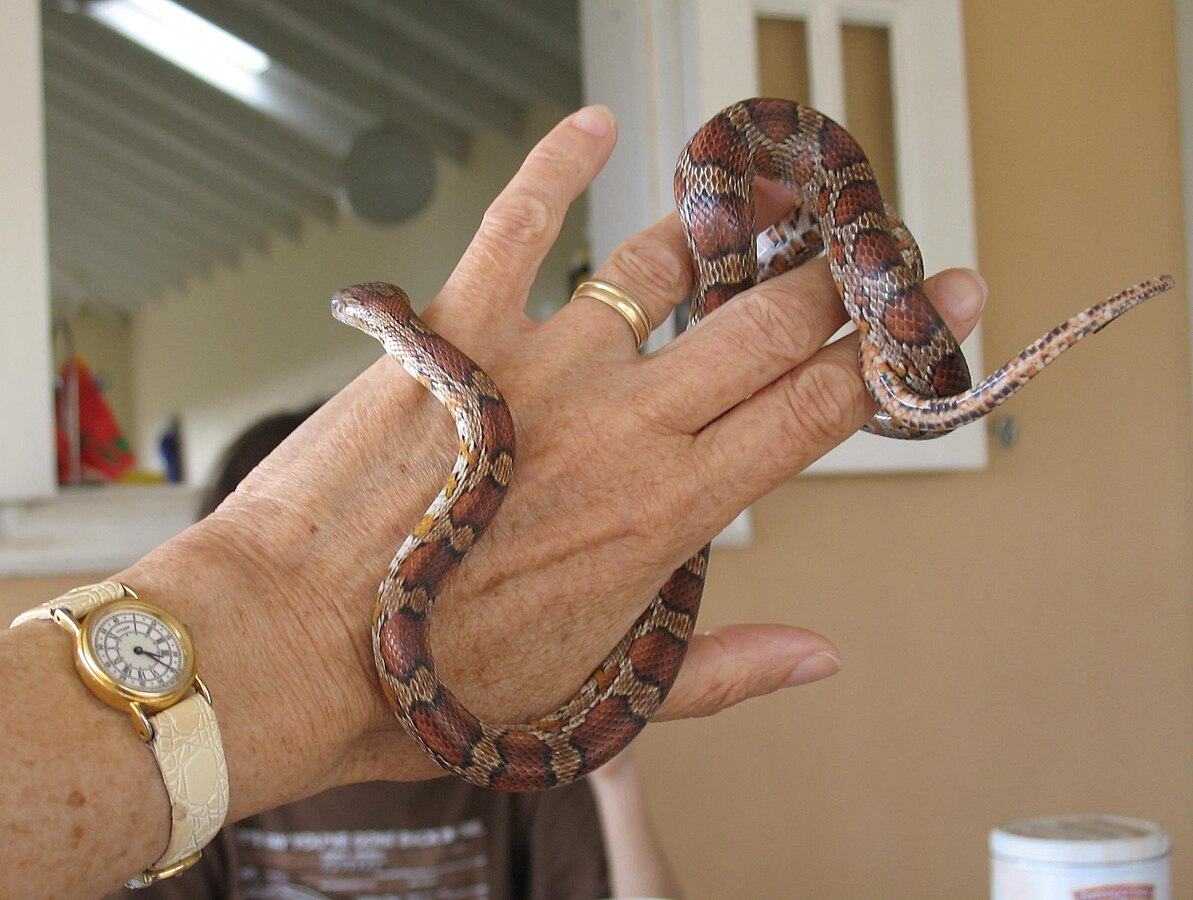
When you come across a corn snake, it’s essential to know how to identify if it poses any danger. Harmless corn snakes typically have distinctive characteristics that set them apart from venomous or aggressive snakes.
Slender Bodies and Vibrant Patterns
Corn snakes are distinguished by their slender, streamlined bodies, often brightly patterned with vibrant colors. These patterns can resemble the kernel of an Indian corn, hence the name “corn snake.”
Their coloration varies widely, from reds, oranges, browns, and yellows to black and white. Often, these hues are arranged in striking patterns such as saddles or blotches running along the length of their bodies. These vibrant patterns make them an attractive sight and easy to distinguish from other types of snakes, especially venomous species.
Docile Demeanor
Another crucial aspect of identifying a harmless corn snake is their behavior. Typically, they are docile and shy creatures unless they feel threatened or alarmed. They will often attempt to escape when encountered rather than displaying aggression.
While this characteristic does not universally apply to all non-venomous snakes, it is a good general indicator of a harmless snake. It’s important to note that most corn snakes found in captivity are even more docile due to domestication and regular human interaction.
Additional Tips for Identification
If you’re still unsure about the snake you’ve encountered, look out for their pupils – harmless corn snakes have round pupils rather than vertical ones, which are characteristic of many venomous snake species.
It’s also crucial to remember that other than corn snakes, there are several similarly-colored and patterned harmless snake species like kingsnakes and milksnakes that share these physical features. If you have any doubts about the type of snake you’re dealing with, it’s always best to take a cautious approach and seek professional assistance if needed.
By being able to recognize these key traits of a harmless corn snake, you can confidently navigate encounters with these reptiles and ensure safe interactions for both yourself and the snake.
With a solid understanding of identifying harmless corn snakes, let’s now turn our attention to exploring the dietary preferences and habits of these intriguing reptiles.
Diet and Habits of Corn Snakes
Corn snakes exhibit fascinating eating habits. In the wild, they are nocturnal hunters, primarily seeking prey at night, with a diet primarily consisting of small rodents like mice and rats. This distinct feeding behavior not only plays a crucial role in controlling rodent populations but also earns them recognition as essential pest control partners.
Their hunting method is equally captivating. As constrictor snakes, corn snakes subdue their prey by coiling around them and applying pressure until the prey suffocates. Despite appearing daunting, this natural instinct enables their survival in the wild. This approach allows them to capture their prey without venom, rendering them safe and non-threatening to humans.
When discussing feeding frequency, adult corn snakes typically consume food every 7-10 days, with younger snakes requiring more frequent feeding, approximately every 5-7 days. They are opportunistic feeders with a palate for various small mammals, birds, and even eggs in their natural habitat. However, in captivity, their diet primarily consists of suitably sized mice or rats. Some individuals may even accept other prey items such as chicks or quail eggs.
It’s remarkable to witness their adaptability when transitioning from the wild to captive environments. In captivity, they consistently display an acceptance of the provided food items.
Understanding the dietary requirements of corn snakes is crucial for providing appropriate care and ensuring they remain healthy in captivity. Offering a suitable diet guarantees they receive essential nutrients for proper growth and development.
It’s evident that comprehending the dietary needs and natural hunting habits of corn snakes is pivotal for their care and conservation. Whether in the wild or as beloved pets, these remarkable reptiles significantly contribute to the balance of their ecosystems while captivating enthusiasts with their unique characteristics and behaviors.
In conclusion, gaining insight into the dietary preferences and predatory habits of corn snakes not only fosters a deeper understanding of these creatures but also underscores the significance of responsible stewardship for their well-being and ecological value.
